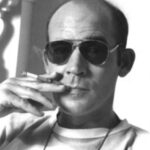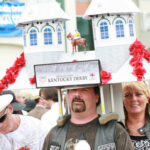In the annals of popular journalism, no one has done as much as Hunter S. Thompson to revolutionize and create controversy in this institution. His unique methodology and unorthodox stories have been generally labeled as “gonzo” journalism which is noted because it “blurs the distinction between fact and fiction,” as noted in Contemporary Literary Criticism.
Before gonzo, Hunter Thompson was still not the average journalist, but his stories were much more standardized. He wrote for a few small papers in his hometown of Louisville, Kentucky where he was born on July 18, 1939. Most of Thompson’s time after high school was spent working odd- jobs and getting into trouble with his friends. Finally, this lifestyle caught up with him and he joined the Air Force in 1956 to escape a harsh prosecution by the authorities. In the Air Force, through sheer natural talent, he became editor of the base newsletter. His work for the Air Force was recognized to be outstanding and they kept him on even though he purposely wrote about controversial subjects and material on which he was highly opinionated. This combined with his rebellious attitude and air of superiority to infuriate his commanding officers, one of whom stated that “He has little consideration for military bearing or dress and seems to dislike the service and wants out as soon as possible.” When Thompson began moonlighting for a civilian paper under the name Sebastion Owl, he was able to secure an honorable discharge.
With freedom in his hands, Thompson began a sojourn from his Air Force base in Florida to San Francisco where he hooked up with the growing beatnik crowd before he started writing for the National Observer. In 1961 the Observer sent Thompson to South America for two years where he would be their foreign correspondent. He was making good money for the first time but he soon got bored being away from home and he returned in 1963. Shortly after, he met and married his first wife, Sandra Dawn, while working on social issues stories. These stories eventually led to heated arguments with his editors and in 1964 he left the National Observer.
The next two years were dismal and bleak for Thompson and his wife until in 1965 he was contracted by Nation to get a story on the Hell’s Angels. The resulting article drew much acclaim and one critic called it “the first piece of honest writing about the Angels done…for a major publication,” as quoted in Thompson’s biography by William McKeen. It made such an impact that he was given a contract for a book on the same subject. To get the real story of the Hell’s Angels, he spent more than one year with the San Francisco chapter, which ended with a savage beating from several members. During this time, Thompson befriended Ken Kesey who introduced him to LSD. The drug culture of the late 60s fascinated him and he began a great love of drugs that eventually seeped into his every work.
After completing the book, Hells Angels, which he called “a Strange and Terrible Saga of the Outlaw Motorcycle Gang” in 1967, Thompson wrote freelance for several magazines and even covered the 1968 presidential campaign. The highlights of this time were his one-on-one interview with Nixon where he was not allowed to ask any political questions, so they talked about football and his stint at the infamous 1968 Democratic Convention where he was in the crowd being beaten by the police riot squad. Thompson grew ever angrier at “the establishment” and began to disregard his duties to his editors. This is what eventually culminated into the style of gonzo journalism.
The first article credited for being purely gonzo was, “The Kentucky Derby is Decadent and Depraved,” which was so loosely organized and shabbily presented that he thought it would be the last piece he would ever write. When it was all said and done, the article consisted of nothing about what happened during the race; rather, it was a tale of what happened to him as he was trying to get the story. This new approach was considered revolutionary, to Thompson’s surprise and drew much criticism. Some disliked it as being self-indulgent, raw, and filled with inaccuracies, but other, including acclaimed writer Kurt Vonnegut, Jr., loved it, saying that he saw it as “the literary equivalent of cubism: All rules are broken; we are shown pictures such as no mature, well-trained artist ever painted before, and in the crazy new pictures we somehow see luminous new aspects of beloved old truths.
The time is now 1971 and Thompson, armed with his new style of “being” the story, was looking for regular work to show off his talent. Shortly, he met Jann Wenner, editor of the yet young Rolling Stone magazine and for them he wrote what would turn out to be his masterpiece.
Fear and Loathing in Las Vegas” took off like a rocket and sent Thompson into the national spotlight. The next year his serialized article about his strange journey to Vegas with his over-sized and equally crazed Samoan attorney was put into book form. This made him even bigger and Rolling Stone with him. Thompson wanted desperately to get into politics, so Wenner established the “National Affairs Desk” in Washington, DC with Hunter at the helm.
From his new position, Thompson covered the 1972 presidential race with weekly reports and on-the-spot updates which were later compiled into his third book, Fear and Loathing: On the Campaign Trail ’72. This book made it big because all the other books published about the campaign were retrospective analysis while Thompson’s book was all first-hand accounts.
After these successes, Thompson wrote less and less, enjoying his time in the spotlight. He had sporadic articles published few and far between that covered such diverse topics as Watergate, the Ali-Foreman fight in Zaire, and the fall of Saigon. He mostly stayed with Rolling Stone, but took a few offers other noted magazines as well. Instead of writing, Thompson turned his attention to the lecture circuit at colleges and universities across the country which usually turned into rap sessions about drug-use and long stories of times under the influence.
In 1979 Thompson published a retrospective of his earlier works called The Great Shark Hunt which would be the first of his four volume series, The Gonzo Papers. He remained fairly inactive during this period, bringing in huge sums of money from royalties and other sources, including a movie based on his life starring Bill Murray entitled, Where the Buffalo Roam.
One factor affecting Thompson’s output was the divorce from his wife of seventeen years. Between 1980 and 1983, when his next book, The Curse of Lono was published, he wrote few pieces, becoming a recluse in a wooded cabin in Woody Creek, Colorado until he came out of hiding to work for the San Francisco Examiner as a columnist in 1985. He stayed with them for well after his next book was printed in 1988 which was a collection of his Examiner articles. This book, called A Generation of Swine: The Gonzo Papers v. 2, hit the best-seller list and re-established Thompson’s name among journalists.
After this time, Thompson again secluded himself in his Woody Creek “bunker,” writing little except for another political retrospective called Songs of the Doomed: The Gonzo Papers v. 3 which was published in 1990 and his new book, an endorsement of Clinton in the 1992 campaign, Better Than Sex: Confessions of a Political Junky.
Thompson remained largely out of the spotlight until a movie adaptation was finally in the works for Fear and Loathing in Las Vegas after several failed attempts. Directed by Terry Gilliam and starring Johnny Depp and Benicio Del Toro, the movie splashed onto the scene with Thompson’s full approval. Depp had stayed with Thompson at his ranch “Owl Farm” in Woody Creek for 4 months learning every mannerism and nuance that would be needed. The two became hard and fast friends until Thompson’s untimely demise on February 26, 2005 from a self-inflicted gun-shot wound to the head. Thompson had succumbed to several painful medical conditions that left him wheelchair bound and unable to enjoy life. It was Depp who financed Thompson’s last request, that the ashes from his cremation be shot out of a 153 foot tall canon that he had designed himself year earlier. 280 guests attended the event, including Senator John Kerry, George McGovern, Charlie Rose, Ed Bradley, Jack Nicholson, Bill Murray, Benicio Del Toro, and Sean Penn.
Hunter S. Thompson will always be remembered for his contributions to journalism and society in general.





